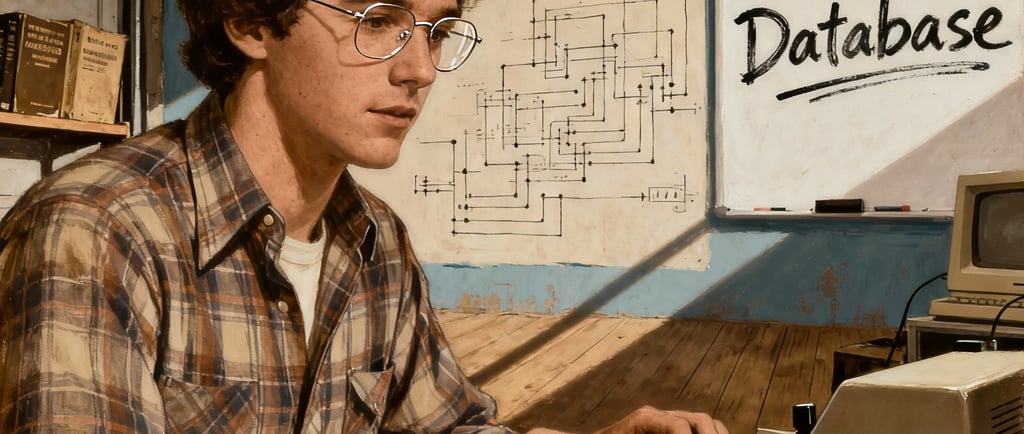
From Orphan to Oracle
How Larry Ellison Built a Tech Empire from Nothing
Shane Brown
10/15/20256 min read


From Orphan to Oracle: How Larry Ellison Built a Tech Empire from Nothing
Lawrence Joseph Ellison went from abandoned infant to one of the world's wealthiest people. Born in New York City on August 17, 1944, to a 19 year old unwed mother, his life started with uncertainty and hardship. But adversity became his advantage. He transformed every setback into fuel for what became Oracle Corporation, now a software powerhouse generating over $57 billion in annual revenue.
A Childhood Marked by Loss and Rejection
When Larry contracted pneumonia at nine months old, his biological mother, Florence Spellman, made the heartbreaking decision to give him up for adoption. She sent him to Chicago to be raised by her aunt and uncle, Lillian and Louis Ellison. The couple provided a stable home in Chicago's South Shore neighborhood, but life was far from easy.
His adoptive father, Louis, had lost his real estate business during the Great Depression and worked as a government auditor. The household was modest and financially strained. Louis was stern, emotionally distant, and often dismissive of young Larry. He repeatedly told him he was "good for nothing." Ellison didn't learn he was adopted until age 12. This revelation intensified his lifelong struggle with identity and belonging.
Despite the emotional turmoil, young Ellison showed natural aptitude in mathematics and science. After graduating from South Shore High School, he enrolled at the University of Illinois at Urbana-Champaign as a pre-med student. He was even named Science Student of the Year. But tragedy struck during his sophomore year when his adoptive mother Lillian died. She had been his one source of warmth and support.
Devastated, Ellison left school without completing his final exams.
The College Dropout Who Learned to Code
After a summer in California, Ellison enrolled at the University of Chicago for a single semester. Though he dropped out again, that brief time proved pivotal. There he first encountered computer programming. His adoptive father's prediction seemed to be coming true. At 21, with no degree and no clear direction, Ellison packed his few belongings into his car and drove from Chicago to Berkeley, California. He had jeans, t-shirts, a leather jacket, and a guitar.
He arrived with enough money for fast food and a few tanks of gas.
For the next eight years, Ellison bounced between jobs as a computer programmer and technician. He worked for companies like Fireman's Fund, Wells Fargo, and Ampex Corporation. At Ampex, he worked on a database project with a code name that would change his life: Oracle. The project was for the Central Intelligence Agency.
The Birth of Oracle: A CIA Contract and a Bold Gamble
In 1977, Ellison read a research paper published by IBM about a new database programming language. SQL (Structured Query Language) was revolutionary. Recognizing the commercial potential IBM had overlooked, Ellison convinced his former boss Robert Miner, along with colleagues Ed Oates and Bruce Scott, to co-found Software Development Laboratories. They started with $2,000 of their own money.
Their first major break came when the CIA hired them to build a relational database. The same Oracle project Ellison had worked on at Ampex. The agency provided a $50,000 contract. This not only funded Oracle's early development but gave the fledgling company legitimacy few startups had.
Ellison and his team made a smart marketing move. They called their first commercial release "Oracle Version 2," deliberately skipping version 1. "We knew no one would want to buy version 1," Ellison later explained. The strategy worked. By 1979, they had built the world's first commercial relational database using SQL.
The company formally renamed itself Oracle Systems Corporation in 1982, aligning its identity with its flagship product. When IBM signed on as an Oracle customer, the company's credibility soared.
Aggressive Growth and Near Collapse
Oracle's rise through the 1980s was meteoric. By 1985, the company generated more than $23 million in revenue. The following year, that figure more than doubled to $55.4 million. On March 12, 1986 (one day before Microsoft went public), Oracle held its initial public offering on the NASDAQ exchange. Shares sold at $15 each. By the end of the first trading day, shares closed at $20. An investor who purchased $1,000 worth of stock that day would see their investment grow to over $7 million by 2025, after accounting for multiple stock splits.
Oracle's success was driven by Ellison's relentless leadership style. He fostered a fiercely competitive, win-at-all-costs culture. This translated into aggressive market strategies. Ellison told his sales teams to promise features that didn't yet exist. He told them to undercut competitors with steep discounts. He publicly named competitors in Oracle's advertising. This was a bold, controversial tactic at the time.
His famous rivalry with Microsoft and Bill Gates exemplified this combative approach. "We pick our enemies carefully," Ellison once said. "We decided to pick a fight with the biggest, most dangerous bully in the schoolyard."
But Oracle's aggressive tactics eventually caught up. In 1990, the company announced a 54% jump in quarterly revenues but only a 1% rise in net earnings. Investigations revealed Oracle had booked revenue prematurely. They overstated sales by more than $50 million. This accounting scandal wiped out $2.7 billion in market value overnight. The company laid off 10% of its workforce.
Many predicted Oracle's demise. But Ellison's resilience proved stronger than the crisis. By 1992, Oracle was back in the black.
Reinvention and Dominance
Throughout the 1990s and 2000s, Ellison demonstrated an ability to anticipate technological shifts. Oracle championed client-server computing early in the decade. Then they pivoted aggressively to internet-ready products before most competitors recognized the web's potential. The company's early embrace of the internet positioned Oracle to lead the market when fully functional internet-powered enterprise software became the standard.
Ellison's acquisition strategy further solidified Oracle's dominance. He made high-profile purchases of PeopleSoft, Siebel Systems, and Sun Microsystems. These eliminated key competitors while expanding Oracle's product offerings. In 2010, the acquisition of Sun Microsystems gave Oracle the Java programming language, Solaris operating system, and the popular open-source MySQL database.
By the time Ellison stepped down as CEO in 2014 after 37 years at the helm, Oracle had become the world's second-largest software company.
AI Boom and Unprecedented Wealth
In 2025, Oracle experienced a resurgence driven by artificial intelligence. The company's cloud infrastructure partnerships with AI giants like OpenAI fueled explosive growth. Oracle's contract backlog grew over 350% year-on-year to $455 billion in a single quarter. CEO Safra Catz projected that Oracle's cloud infrastructure revenue would rise 14-fold (from around $10 billion to $144 billion) by May 2030.
As of October 2025, Larry Ellison's net worth stands at approximately $359 billion. This makes him the world's second richest person behind Elon Musk. His wealth has roughly doubled in 2025 alone, growing by an unprecedented $195 billion. On September 10, 2025, Ellison briefly became the world's richest person when his net worth reached $393 billion.
Giving Back on His Own Terms
In 2010, Ellison joined the Giving Pledge. He promised to donate at least 95% of his wealth to charitable causes. Unlike many billionaires, Ellison has chosen to give on his own terms. He does this primarily through the Ellison Institute of Technology (EIT), a for profit organization based at the University of Oxford.
EIT focuses on global challenges. These include healthcare, food insecurity, climate change, and AI research. A $1.3 billion campus is scheduled to open in Oxford by 2027. Ellison has also contributed $200 million to the University of Southern California for cancer research. He gave approximately $1 billion to the Ellison Medical Foundation, which focused on aging and disease prevention before closing.
Lessons from a Life of Adversity
Ellison's journey offers profound lessons for anyone facing adversity. His most famous quote captures his philosophy: "I have had all the disadvantages required for success." Rather than viewing his difficult childhood, his adoption, his financial struggles, and his lack of formal education as barriers, Ellison transformed them into strengths. These fueled his ambition.
"The most important aspect of my personality as far as determining my success goes has been my questioning conventional wisdom, doubting experts, and questioning authority," Ellison once said. This rebellious streak (born from a childhood of feeling like an outsider) became his greatest asset in business.
He advises entrepreneurs: "If you do everything that everyone else does in business, you're going to lose. The only way to be ahead is to be different." Oracle succeeded not because they invented the database. They succeeded because Ellison saw commercial potential IBM missed and executed with unmatched aggression.
"When you innovate, you've got to be prepared for people telling you that you are nuts," Ellison reminds us. From dropping out of college twice to betting everything on a CIA database project, Ellison's career is defined by bold risks. Conventional wisdom would have rejected these risks.
Perhaps most importantly, Ellison never let failure define him. "Great achievers are driven, not so much by the pursuit of success, but by the fear of failure," he observed. When Oracle nearly collapsed in 1990, Ellison didn't give up. He restructured, adapted, and came back stronger.
A Legacy of Resilience
Today, Oracle Corporation stands as a testament to what's possible when adversity meets determination. From a nine-month-old infant battling pneumonia to an 81-year-old tech titan reshaping the AI landscape, Larry Ellison's story proves something important. Your circumstances at birth don't determine your destiny.
For anyone who feels they've started life with too many disadvantages (whether poverty, family dysfunction, lack of education, or bad luck), Ellison's journey offers hope. He transformed every disadvantage into fuel, every setback into a lesson, and every rejection into motivation.
"I believe people have to follow their dreams. I did," Ellison says.
And in following that dream from the streets of Chicago to the pinnacle of Silicon Valley, he built not only a company but proof. The obstacles you face become the foundation of extraordinary success.
